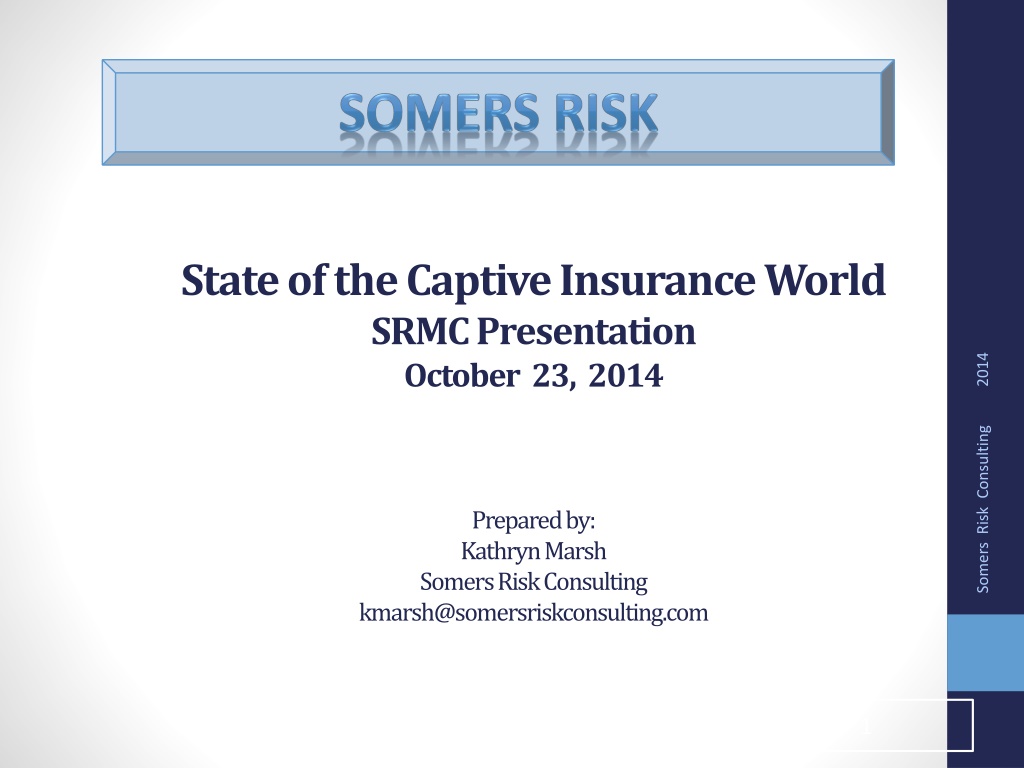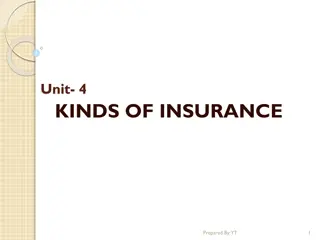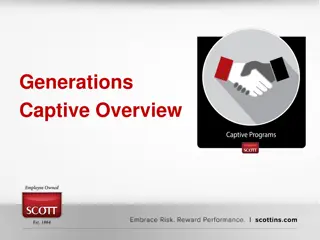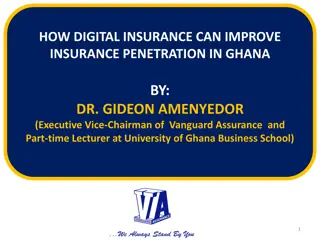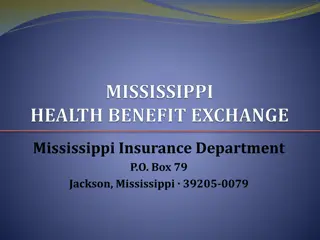Understanding the State of the Captive Insurance World
Explore insights into the current trends and developments in the captive insurance industry, including micro-captive structures, 831(b) company options, IRS positions, and sample pooling arrangements. Learn about the benefits, risks, and regulatory scrutiny affecting captives as outlined by Somers Risk Consulting. Discover the opportunities and challenges of utilizing captives for risk management and tax efficiency.
Download Presentation

Please find below an Image/Link to download the presentation.
The content on the website is provided AS IS for your information and personal use only. It may not be sold, licensed, or shared on other websites without obtaining consent from the author. Download presentation by click this link. If you encounter any issues during the download, it is possible that the publisher has removed the file from their server.
E N D
Presentation Transcript
Stateof theCaptive InsuranceWorld SRMC Presentation October 23, 2014 Somers Risk Consulting 2014 Prepared by: Kathryn Marsh Somers Risk Consulting kmarsh@somersriskconsulting.com 1
Index What we are Seeing in the Captive World Micro-Captive Update Pooling Arrangement Example Recent Case Studies Appendix 831(b) mechanics Somers Risk Consulting 2014 2
What we are seeing Continued interest in captives both large and small Insurance community continues to recommend Accountants, lawyers and financial consultants learning and recommending more. More creative uses of captives as owners recognize additional Somers Risk Consulting 2014 revenue potential and/or risk management potential Domiciles continue to compete and become increasingly business friendly. New entrants vying for business. 3
Micro-Captive /831(b) Company Option Ever increasing interest and growth in this sector primarily due to the recognition of the following benefits: Potential to insure and pre-fund enterprise risks in a highly tax efficient manner. These risks have typically been self-insured with no proactive approach to mitigation. Potential to share risk and decrease exposure to catastrophic or large losses Asset protection Favorable tax treatment Estate planning/wealth transfer Me too factor! Somers Risk Consulting 2014 4
IRS Position IRS continues its of scrutiny of 831(b) captives through a review of the more aggressive pooling arrangements. Many were openly developed as tax shelters: No business purpose No proper process for pricing risk or excessive pricing Somers Risk Consulting 2014 No documentation Circular flow of cash money paid into captive, loaned back out, etc. Captive funds were used to buy life insurance Well constructed, more conservative programs are not being reviewed. Message Microcaptives are a very legitimate risk management tool and can have significant positive tax advantages but they must be formed for the right reasons and have operations 5 consistent with traditional insurance companies.
Sample 831(b) Pooling Arrangement A reinsurance pool that allows participating captive insurance companies to pool risk among themselves. Typically about 50% of the captive s total premium is ceded to the pool and a similar premium is retroceded back to the captive. The retroceded premium is a mix of premium from all participants. It is unrelated, third party business and, as such, qualifies the captive as a bona fide insurance company. Insurance companies qualify for favorable tax treatment. Simple excess of loss structure with relatively small excess layer ceded to the pool ($210K xs $15K). Participants share risk within layer on quota share basis. Provides reinsurance protection for captives against mid-size claims. Substantially reduces volatility in captives underwriting results. Excellent risk distribution. Pool protected by aggregate reinsurance from third party reinsurer. 6
Pool Details About 65 participants with total pool premium of approximately $30 million. Reinsurance protection. Losses between 0.625% and 3% of total pool premium are paid by the reinsurer. (Currently translates into losses of between about $187.5K and $900K). 7 Participants expect to pay some level of claims each year. Historical results range from years when no losses to losses of $300 + per $100,000 in premium.
Top 10 Pool Coverages 1. Reputational damage 2. Express and implied warranty 8 3. Loss of key customer 4. Loss of key employee 5. Administrative actions 6. Contingent business interruption/loss of revenue/work stoppage 7. Computer data restoration/cyber 8. Wrongful acts 9. Loss of key supplier 10.Work stoppage Premiums are currently determined by five different actuarial firms.
Case Studies Somers Risk Consulting 2014 12
Case Study 1 Client Property Manager Facts: Property manager client - managing about 100K units. For some properties, they have offered the property owner an alternative to the collection of security deposits. They offer an insurance alternative which covers the risk of damage to property and loss of rents in the case a tenant breaks a lease. The property owner increases the monthly rent to cover the premium payment - usually by 1-2% of the rental amount. The property manager has established an insurance agency which pays commission of about 15% on these policies. Loss ratios to date are in the range of 25%. Somers Risk Consulting 2014 Solution: Develop a fronted arrangement with an A-rated carrier to provide a similar insurance policy. Establish a captive to 100% reinsure the fronting company. Result is more control over the coverage provided and pricing. Large revenue source versus a previous costly expense area (cost of monitoring security deposit escrow funds, litigation). More than double the revenue they obtain from the agency program. 13
Case Study 2 Client Entertainment company Facts: TV Production company with many uninsured risks related to production. Would like protection but, if coverage is even available, does want the coverage at price charged by specialty markets Somers Risk Consulting 2014 Solution: Establishing a captive which makes the 831(b) election to obtain the tax efficiencies. Will cover the risks including: Administrative action, regulatory change, legal expense, contingent business interruption, cyber liability including data restoration, exclusion buyback and excess on P/C policies, intellectual property, work stoppage, reputational damage, and a few others. Using a pooling arrangement to share the risk and purchase reinsurance protection. Client obtains coverage for risks otherwise self-insured at very reasonable price and in a very tax efficient manner. 14
Case Study 3 Client Staffing Company Facts: Staffing company having issues with obtaining WC coverage. Has cash flow and wishes to increase deductibles and retain more risk but current carrier is not allowing and at same time is threatening cancellation. Solution: Somers Risk Consulting 2014 We believe we have found a specialty front company that will write the risk on a high deductible basis. Will establish a captive to insure the deductible layer as well as other self-insured risks. Will use a pool to share the non-WC risks (the pool doesn t want to cover the WC risks). 15
For more information. Contact: Kathryn Marsh Somers Risk Consulting kmarsh@somersriskconsulting.com 770-645-2242 (o) 770-286-7551 (c) Somers Risk Consulting 2014 16
Kathryn Marsh, Managing Director Somers Risk Consulting Kathryn Marsh is a seasoned consultant within the alternative risk industry with over 30 years of experience in various facets of the industry. After many years of working for various large and small companies, she has formed Somers Risk Consulting which specializes in captive and alternative risk consulting and captive management. Prior to establishing Somers Risk Consulting, Kathryn held high level consulting positions with boutique captive consulting firms as well as large firms such as KPMG and AON. At AON she headed the company s regional quantitative and alternative risk groups, and was Chair of the company s Captive Council, a network of the key captive personnel worldwide. Her employment at KPMG was within the Structured Risk Financing Group of KPMG s Tax Practice where she was fully immersed in captive tax strategy. Kathryn also spent a number of years managing captive insurance companies in Bermuda with Marsh and was the Director of Risk Management for NCR Corporation. Most recently she was the insurance expert within the management team of a cell phone insurance company where she structured and implemented the risk program which helped grow the entrepreneurial company into one that was recently acquired by Brightstar, a $5 billion global distributor of mobile communication equipment. Somers Risk Consulting 2014 Kathryn has a Bachelor of Business Administration degree majoring in Insurance from St. John s University in New York and an MBA with a double major in Finance and Multinational Management from the Wharton School of the University of Pennsylvania. She holds the Chartered Property and Casualty Underwriter (CPCU) and Associate in Risk Management (ARM) designations. 17
Appendix Somers Risk Consulting 2014 18
What is a Micro-Captive? Section 831(b) of the IRS Code allows Property/Casualty insurance companies writing under $1.2 million in premium to be taxed on investment income only. They are not taxed on underwriting income. Somers Risk Consulting 2014 19
How does it work? Premium payments from company to insurance company are a tax-deductible expense Premium less losses/expenses = underwriting profits. Underwriting profits grow in captive untaxed. Annual therefore, ability to have significant tax-free growth Typically, tax will be paid on dividends when paid - typically at dividend/capital gains rates currently 20% for top tax rate payers. Somers Risk Consulting 2014 20
An Example Financials Assuming No Losses Single Year Insured Company s financials: Premium payment Tax Deduction After tax cost $1,000,000 400,000 $600,000 Net Cost = $600,000 Captive Insurance Company financials: Somers Risk Consulting 2014 Premium income Captive Admin Expenses Losses Underwriting Income Tax due After tax Retained Earnings $1,000,000 70,000 -0- Net Value = $930,000 930,000 -0- $930,000 Annual Benefit = $330,000* Assumptions: Captive qualifies as a bona fide insurance company Tax rate is 40% (combined federal and state) Investment income is ignored (will be subject to taxation typically federal only, not state) Assumes no losses. Loss activity will reduce benefit. There will be a capital requirement in the first year of captive formation - $120K minimum *Although tax savings are significant, the primary reason for forming a captive should not be tax motivation but to meet risk management needs. 21
An Example Financials Assuming No Losses After 5 Years Insured Company s financials: Premium payment Tax Deduction After tax cost $5,000,000 2,000,000 $3,000,000 Net Cost = $3,000,000 Captive Insurance Company financials: Somers Risk Consulting 2014 Premium income Captive Admin Expenses Losses Underwriting Income Tax due After tax Retained Earnings $5,000,000 350,000 -0- Net Value = $4,650,000 $4,650,000 -0- $4,650,000 Five Year Benefit = $1,650,000 Assumptions: Captive qualifies as a bona fide insurance company Tax rate is 40% (combined federal and state) Investment income is ignored (but will be subject to taxation typically federal only/not state) Assumes no losses. Loss activity will reduce benefit. There will be a capital requirement in the first year of captive formation - $120K minimum *Although tax savings are significant, the primary reason for forming a captive should not be tax motivation but to meet risk management needs. 22
An Example Estate Planning Vehicle With Captives owned by One Heir After 5 years Insured Company s financials: Premium payment Tax Deduction After tax cost $ 5,000,000 2,000,000 $3,000,000 Net Cost = $3,000,000 Reduction in Value of Estate Reduction in Estate Taxes Unknown but tax rates have been as high as 55-60% in past Assume 2013 40% Rate $ 2,000,000 $ 5,000,000 Somers Risk Consulting 2014 Total of Financials of Captive Insurance Companies owned by 3 Heirs : Premium income Captive Admin Expenses 350,000 Losses Underwriting Income $ 4,650,000 Tax due After tax Retained Earnings $ 5,000,000 -0- Net Value = $4,650,000 -0- $ 4,650,000 Five Year Benefit = $2,000,000 + $1,650,000= $3,650,000 Assumptions: Captive qualifies as a bona fide insurance company Tax rate is 40% (combined federal and state) Investment income is ignored (will be subject to taxation - typically federal only/not state) Assumes no losses. Loss activity will reduce benefit. There will be a capital requirement in the first year of captive formation - $120K minimum *Although tax savings are significant, the primary reason for forming a captive should not be tax motivation but to meet risk management needs. 23
